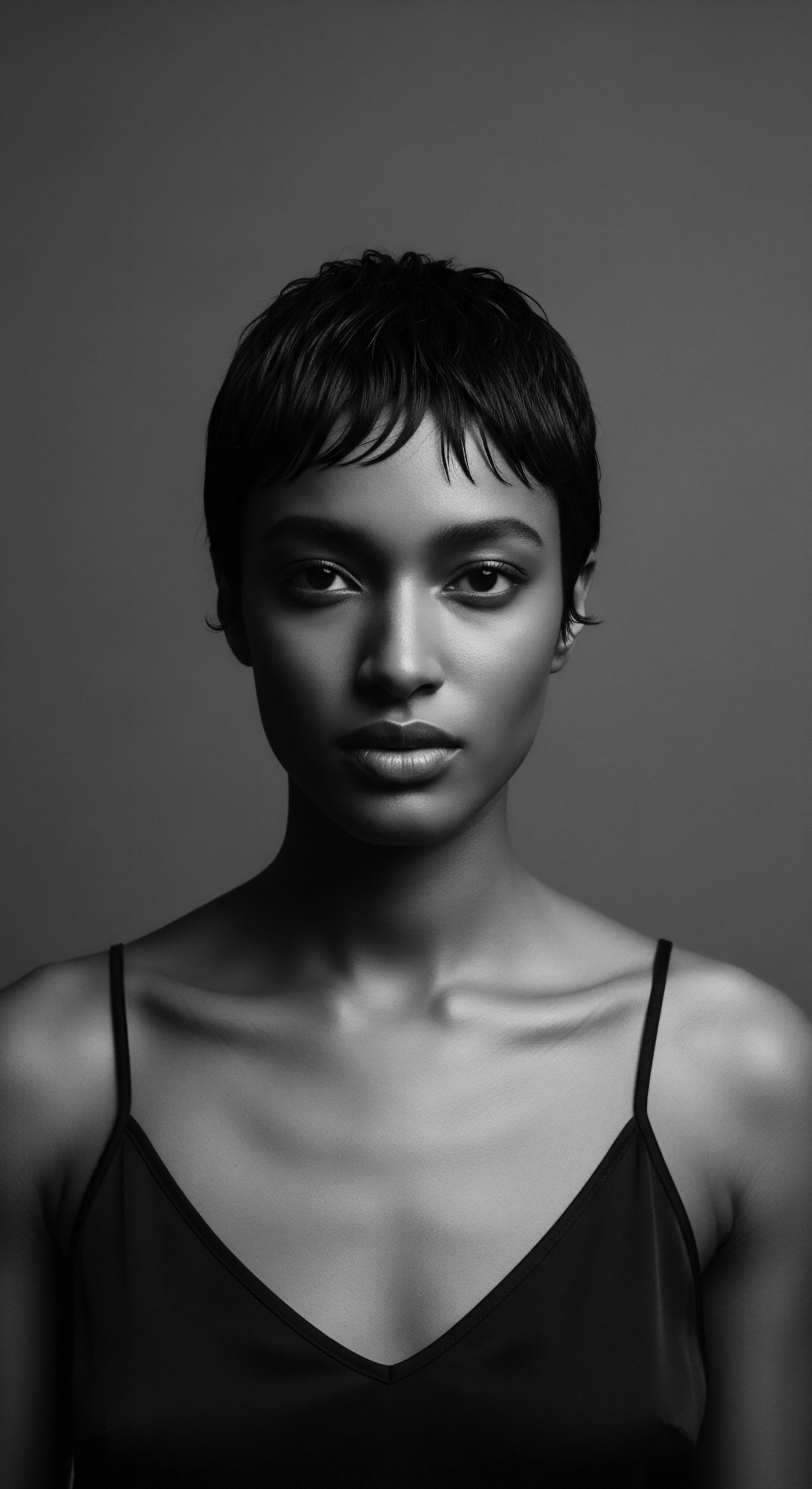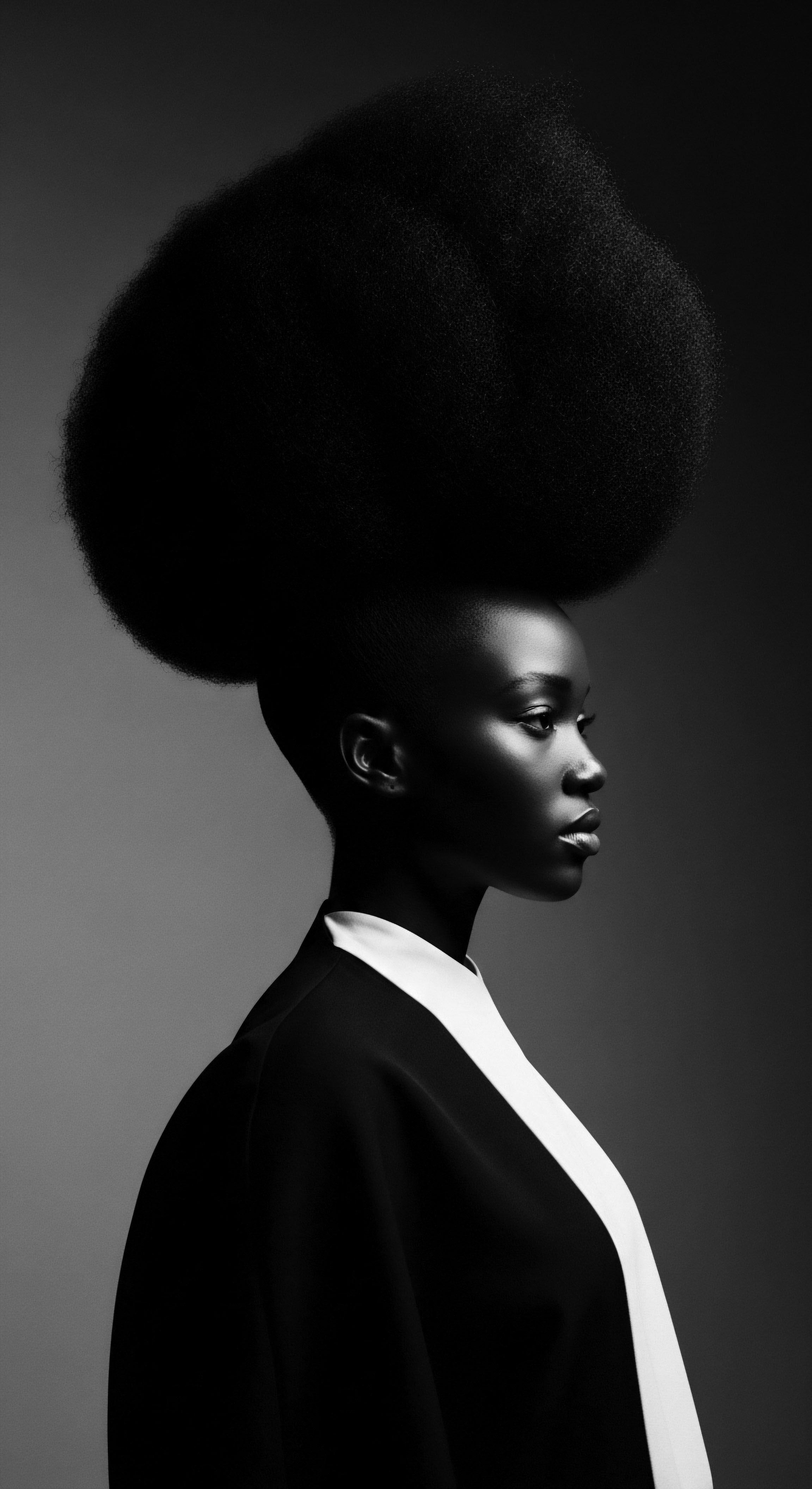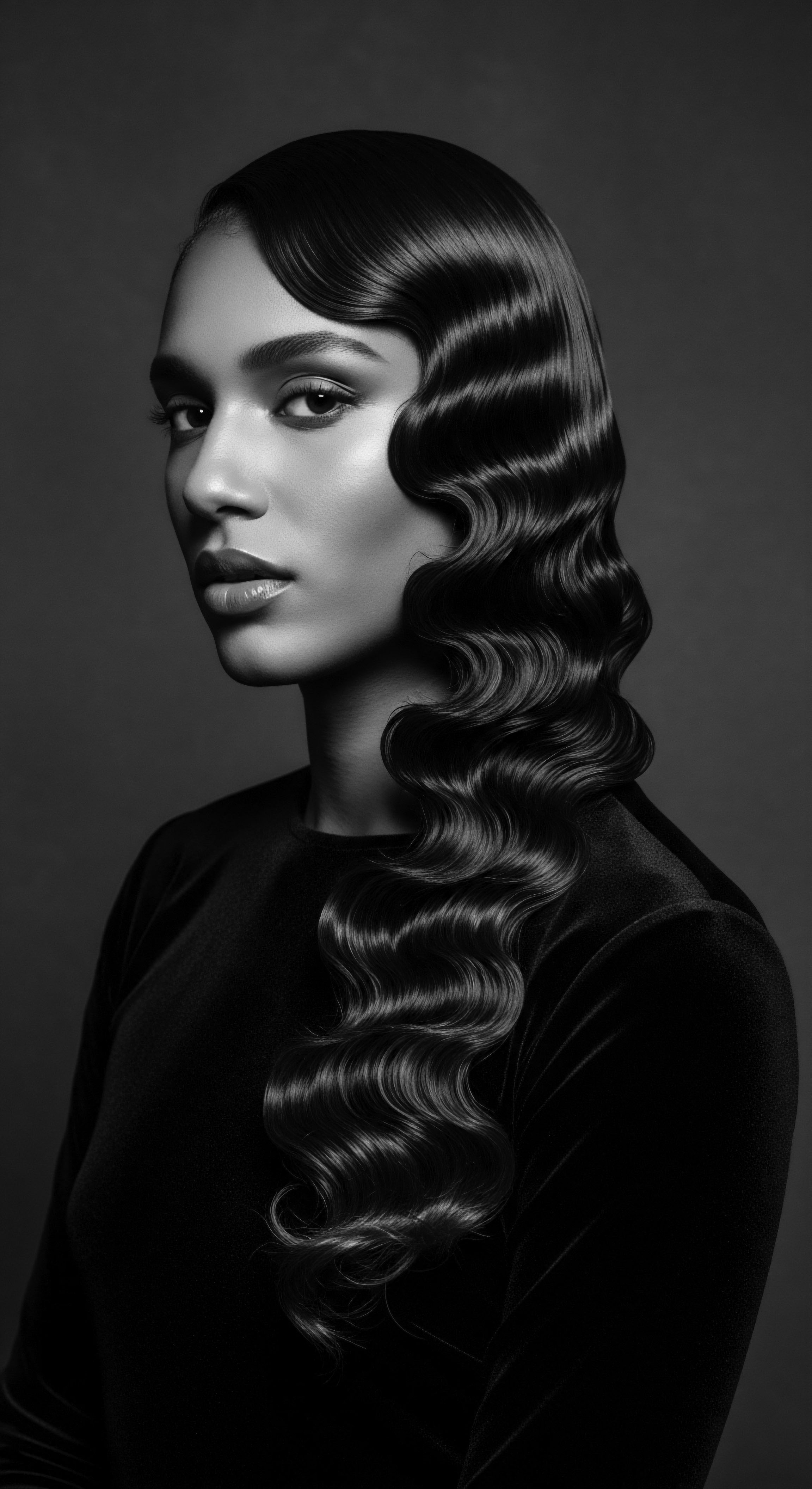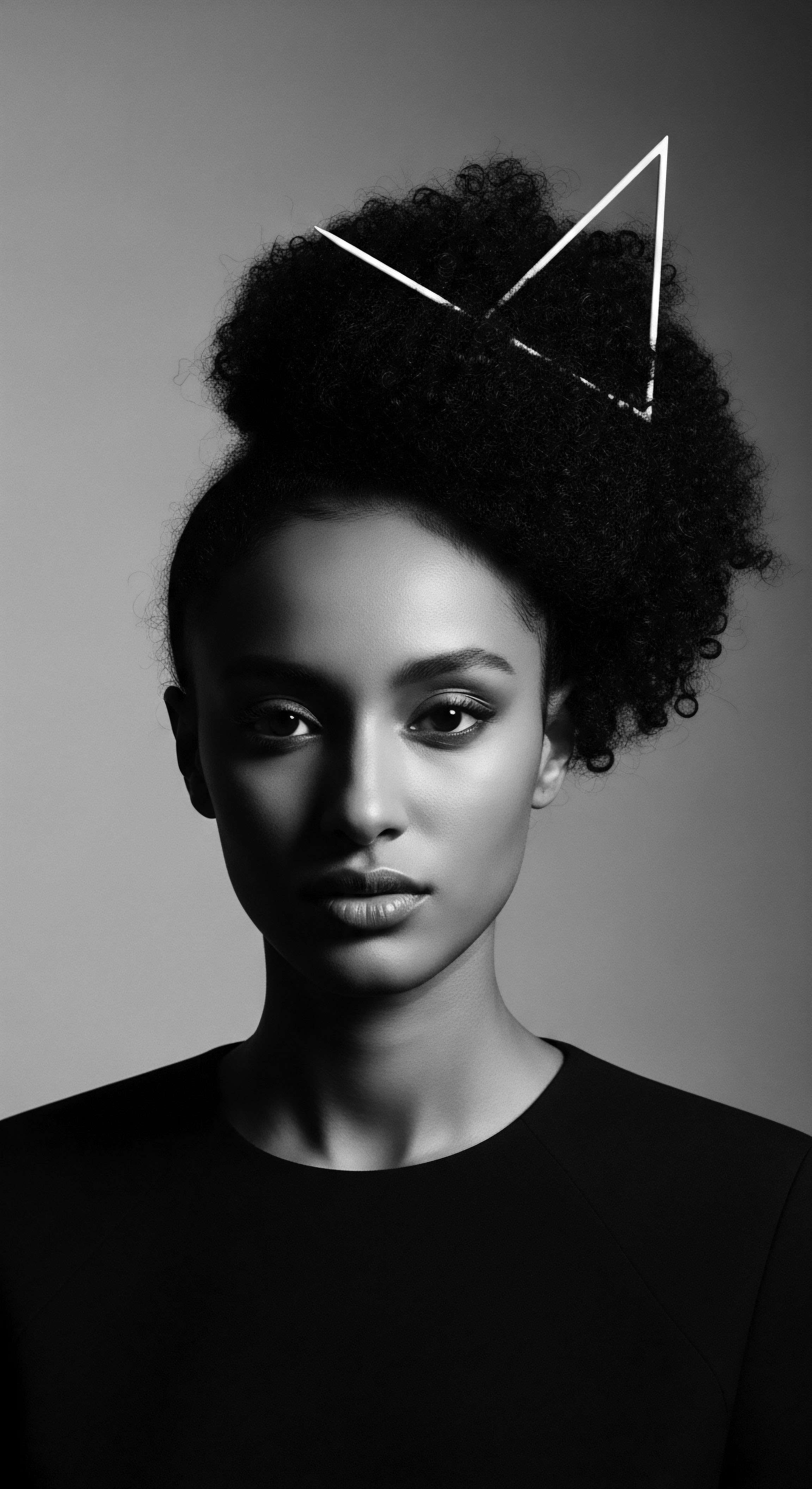
Fundamentals
The understanding of Natural Beauty, within the living library of Roothea, transcends a fleeting trend or a superficial aesthetic. It is an acknowledgment, a deep recognition, of the inherent splendor residing within the original state of one’s hair, particularly emphasizing the rich diversity of textured hair. This concept suggests a fundamental alignment with ancestral blueprints, a reverence for the genetic heritage that shapes each curl, coil, and wave. Natural Beauty, at its most straightforward, is the acceptance and celebration of hair as it emerges from the scalp, unaltered by chemical processes designed to impose a different texture or form.
For Roothea, the meaning of Natural Beauty is inextricably linked to the journey of self-discovery and the reclamation of identity, especially for individuals of Black and mixed-race heritage. It is a departure from imposed beauty standards, often Eurocentric in origin, that have historically devalued textured hair. This perspective invites a gentle inquiry into the biological truths of hair—its unique protein structures, its moisture needs, its growth patterns—and how these elemental facts connect with centuries of traditional care practices. The explication of Natural Beauty is not merely about appearance; it is about recognizing the profound connection between one’s hair and their ancestral story.
The delineation of Natural Beauty encompasses several core ideas ❉
- Authenticity ❉ The state of hair in its unprocessed, inherent form, reflecting one’s genetic lineage without chemical modification.
- Health ❉ A condition of hair that is well-nourished, strong, and vibrant, often achieved through practices that honor its natural structure.
- Identity ❉ The profound link between hair texture and personal, cultural, and ancestral heritage, particularly for Black and mixed-race individuals.
- Self-Acceptance ❉ The conscious decision to value and present one’s natural hair, resisting external pressures to conform to alternative beauty ideals.
This foundational comprehension of Natural Beauty lays the groundwork for a deeper exploration into its historical, cultural, and scientific dimensions, always maintaining a respectful stance towards the diverse experiences of textured hair. It is a concept that encourages a return to simplicity, to the wisdom held within generations of Black and mixed-race hair traditions, where care was an act of connection and celebration.

Intermediate
Moving beyond the initial grasp, the intermediate understanding of Natural Beauty for textured hair deepens into its historical and cultural significance, particularly within the Black and mixed-race diaspora. This is where the simple explanation transforms into a resonant interpretation, acknowledging that hair is never merely a physical attribute; it is a profound carrier of heritage, a visual archive of resilience, and a testament to enduring spirit. The historical trajectory of textured hair reveals a continuous dialogue between ancestral practices and societal pressures, a conversation that shapes the contemporary understanding of Natural Beauty.
In pre-colonial African societies, hair held immense social, spiritual, and cultural weight. Hairstyles communicated a person’s age, marital status, tribal affiliation, wealth, and even religious beliefs. Intricate braiding patterns, often taking hours or even days to create, were social rituals, moments for bonding and the transmission of generational wisdom.
Hair was revered as the most elevated part of the body, considered a conduit for spiritual energy and a direct link to the divine and ancestors. This deep, intrinsic value stands in stark contrast to the dehumanizing practices that followed the transatlantic slave trade, where captured Africans were often forced to shave their heads as a brutal act of identity erasure and humiliation.
The legacy of ancestral hair practices, once nearly severed, now unfurls anew, guiding us back to a holistic understanding of hair’s intrinsic worth.
The deliberate denigration of textured hair during and after slavery aimed to strip individuals of their cultural moorings, fostering an internalized belief that anything deviating from Eurocentric beauty standards was “unprofessional” or “unruly.” This historical context shapes the very definition of Natural Beauty today, making its reclamation an act of profound self-determination and cultural affirmation. The journey back to natural hair, often marked by a “big chop” or a gradual transition, represents a conscious shedding of inherited societal norms and a joyous embrace of one’s authentic self.

The Living Traditions of Care and Community
The intermediate understanding also delves into the practical wisdom of traditional hair care, revealing how ancient knowledge informs modern practices. Before the advent of synthetic products, ancestral communities relied on the earth’s bounty for hair nourishment. This involved the use of natural ingredients like plant oils, butters, and herbs, many of which are now being rediscovered for their efficacy.
For example, in Ethiopia, plants such as Ziziphus Spina-Christi and Sesamum Orientale have been traditionally used for hair and skin care, with the former specifically noted for its anti-dandruff properties. Similarly, ethnobotanical studies in Nigeria have identified various plants used as phytocosmetics for hair treatment, showcasing a deep-rooted knowledge of botanical properties.
These traditional practices were not solitary acts; they were communal, strengthening familial bonds and transmitting knowledge across generations. The image of a child nestled between a mother’s thighs, learning the art of braiding, is a timeless tableau of care and connection.
The resurgence of the natural hair movement, particularly since the 2000s, is a powerful contemporary expression of this enduring heritage. It is a collective movement to celebrate Afro-textured hair in its myriad forms—coils, kinks, and curls—and to challenge the persistent biases that deem natural styles as less professional or desirable. This movement is not simply about aesthetics; it is about social justice, mental well-being, and the freedom to express one’s identity without fear of discrimination.
Consider the ongoing efforts to pass legislation like the CROWN Act, which prohibits discrimination based on hair texture and protective styles. This legal push directly addresses the historical and ongoing challenges faced by Black individuals, who are often penalized in academic and professional settings for wearing their natural hair. The very necessity of such laws underscores the deep societal impact of Eurocentric beauty standards and the persistent struggle to redefine what is considered “beautiful” and “professional” in a truly inclusive manner.
| Aspect of Care Ingredients |
| Ancestral Practices (Echoes from the Source) Locally sourced herbs, plant oils (e.g. shea butter, coconut oil), clays, and natural extracts. |
| Contemporary Natural Hair Care (The Tender Thread) Emphasis on natural, sulfate-free, paraben-free products; continued use of traditional oils and butters, often in refined forms. |
| Aspect of Care Techniques |
| Ancestral Practices (Echoes from the Source) Intricate braiding, twisting, threading, hair wrapping, and communal grooming rituals. |
| Contemporary Natural Hair Care (The Tender Thread) Protective styles (braids, twists, locs), wash-and-go methods, deep conditioning, and mindful detangling. |
| Aspect of Care Purpose |
| Ancestral Practices (Echoes from the Source) Spiritual connection, social signaling, cultural identity, health, and community bonding. |
| Contemporary Natural Hair Care (The Tender Thread) Self-expression, identity affirmation, scalp health, moisture retention, and resistance to Eurocentric norms. |
| Aspect of Care The continuity of care, from ancient remedies to modern formulations, illustrates the enduring wisdom embedded in textured hair heritage. |
The interpretation of Natural Beauty, at this intermediate stage, becomes a nuanced understanding of its historical roots and its ongoing evolution as a symbol of cultural pride and individual agency. It recognizes the profound connection between hair, identity, and the collective memory of a people.

Academic
The academic definition of Natural Beauty, within Roothea’s ‘living library,’ transcends superficial aesthetics, positioning it as a complex interplay of genetic inheritance, socio-cultural constructs, and deeply embedded historical narratives, particularly concerning textured hair. This scholarly explication asserts that Natural Beauty, in the context of Black and mixed-race hair experiences, is the manifestation of hair’s inherent structural and biological characteristics, unmodified by chemical straightening agents, yet simultaneously a profound statement of identity, resilience, and cultural continuity against historical and ongoing pressures of Eurocentric beauty ideals. It is a declaration of self-acceptance and a conscious alignment with ancestral lineage, reflecting a deeply informed understanding of both hair science and the anthropology of human appearance.
The precise delineation of Natural Beauty necessitates an examination of its meaning through various lenses. From a biological standpoint, it refers to the hair’s natural curl pattern, density, porosity, and growth cycle as determined by an individual’s genetic makeup. The unique helical structure of Afro-textured hair, for instance, provides it with distinct properties, including elasticity and volume, while also presenting specific care requirements related to moisture retention and detangling.
From a socio-cultural perspective, Natural Beauty is a counter-hegemonic concept, actively challenging and redefining dominant beauty paradigms that have historically marginalized Black and mixed-race hair textures. This perspective acknowledges that what is perceived as “beautiful” is not universally inherent but rather shaped by power dynamics and historical narratives.

The Unbound Helix ❉ Intersections of Biology, History, and Identity
The journey of textured hair, and by extension, the concept of Natural Beauty, is deeply intertwined with historical oppression and subsequent liberation movements. During the transatlantic slave trade, the deliberate shaving of African hair was a primary act of dehumanization, a symbolic severing of cultural and spiritual ties. This initial trauma set a precedent for centuries of hair policing, where textured hair was systematically deemed “unprofessional,” “messy,” or “unruly” within Western societies. This historical context is not merely background; it is the very bedrock upon which the modern concept of Natural Beauty for textured hair is built, transforming it from a simple aesthetic choice into a powerful act of self-reclamation.
A critical case study illustrating this profound connection between Natural Beauty, textured hair heritage, and the Black experience is the pervasive issue of hair discrimination. Research by Lisse (2025) highlights that Black Adolescent Girls are Significantly More Likely to Experience Hair-Related Discrimination and Dissatisfaction Compared to Their White and Latina Peers, with This Dissatisfaction Leading to Increased Feelings of Depression. This statistic is not an isolated finding; it reflects a broader societal bias, empirically demonstrated by studies showing that Black women with natural hairstyles are often perceived as less professional and less likely to secure job interviews, particularly in industries with conservative appearance norms (Rosette, 2020). Such findings underscore that the decision to wear natural hair is not merely a personal preference but a declaration with tangible social and psychological consequences, often requiring immense fortitude.
The inherent bias against textured hair reveals how deeply ingrained historical narratives of subjugation continue to shape contemporary perceptions of beauty and professionalism.
This systemic discrimination has led many Black women to chemically straighten their hair to conform to Eurocentric standards, a process that can be physically damaging and psychologically taxing. The Natural Hair Movement, which gained significant momentum in the 2000s, represents a collective effort to dismantle these ingrained biases and celebrate the inherent beauty of Afro-textured hair. It is a movement that draws direct parallels to the “Black is Beautiful” movement of the 1960s and 70s, where the Afro became a potent symbol of self-empowerment, pride, and resistance against forced assimilation.

Ancestral Wisdom and Scientific Validation ❉ Echoes from the Source
The academic perspective also seeks to bridge the gap between ancestral wisdom and contemporary scientific understanding. Traditional hair care practices, often dismissed as folklore, frequently contain principles that modern science now validates. For instance, the emphasis on scalp health in many indigenous haircare traditions, involving gentle massages and herbal treatments, aligns with current dermatological understanding of promoting blood circulation and a healthy environment for hair growth.
Consider the widespread traditional use of plant-based oils and butters for hair nourishment across African and Caribbean communities. Shea butter, coconut oil, and various herbal infusions have been used for centuries to moisturize, protect, and strengthen textured hair. Ethnobotanical research documents the use of species like Citrullus Lanatus (Kalahari Desert Melon) and Citrullus Colocynthis for hair care in Africa, some of which are now being integrated into commercial natural hair products. This demonstrates a sophisticated, empirically derived knowledge system that predates modern chemistry, showcasing how ancestral practices were, in essence, early forms of applied hair science.
The interconnectedness of physical hair health and mental well-being is another crucial area of academic inquiry. For Black individuals, hair is not merely an appendage; it is deeply symbolic, tied to confidence, cultural continuity, and self-worth. The constant microaggressions and discrimination experienced due to hair can lead to significant psychological distress, including internalized racism, anxiety, and cultural disconnection. Therefore, promoting Natural Beauty is not just about aesthetics; it is a vital component of holistic wellness and psychological liberation for Black and mixed-race communities.
The academic definition of Natural Beauty, as presented by Roothea, is thus a profound statement. It is the recognition of hair’s inherent biology, the acknowledgment of its deeply scarred yet resilient historical journey, and the celebration of its role as a living symbol of identity and resistance. This designation requires a nuanced understanding that integrates historical oppression with cultural resurgence, scientific principles with ancestral wisdom, all culminating in a vision of beauty that is authentic, empowering, and deeply rooted in heritage.

Reflection on the Heritage of Natural Beauty
The journey through the concept of Natural Beauty, as enshrined within Roothea’s ‘living library,’ reveals more than a simple definition; it unveils a profound meditation on Textured Hair Heritage itself. From the elemental biology of each strand, echoing the earliest forms of human existence, to the intricate rituals passed down through generations, Natural Beauty stands as an enduring testament to the resilience and profound cultural richness of Black and mixed-race communities. It is a concept that defies simplification, demanding a reverence for its historical weight and a celebration of its present-day power.
The echoes from the source remind us that our hair, in its natural state, carries the genetic wisdom of our ancestors, a biological signature that connects us directly to the cradle of humanity. The tender thread of care, woven through centuries of communal grooming and the ingenious use of earth’s bounty, speaks to an ancestral wisdom that instinctively understood holistic wellness long before the term became commonplace. This heritage of care, rooted in the meticulous tending of coils and kinks, is not merely about hygiene; it is an act of love, a transmission of knowledge, and a quiet defiance against forces that sought to diminish such practices.
As we observe the unbound helix, spiraling from past to future, we recognize that Natural Beauty is a dynamic, living concept. It is the continuous unfolding of identity, a vibrant expression of self that resists external impositions and embraces the inherent splendor of textured hair. This journey, marked by both historical struggle and triumphant reclamation, calls for an ongoing commitment to cultural understanding, to honoring the wisdom embedded in our hair’s ancestral story, and to forging a future where every strand is celebrated for its unique and profound heritage. Roothea’s dedication to this living archive ensures that the deep meaning of Natural Beauty will continue to inspire, inform, and empower generations to come.

References
- Byrd, A. & Tharps, L. (2001). Hair Story ❉ Untangling the Roots of Black Hair in America. St. Martin’s Press.
- Johnson, T. A. & Bankhead, T. (2014). Hair It Is ❉ Examining the Experiences of Black Women with Natural Hair. Open Journal of Social Sciences, 2(1), 86-100.
- Lisse, A. (2025). Hair Satisfaction and Depressive Symptoms in Black Adolescent Girls. Body Image. (as cited in UConn Researcher Sheds New Light on Importance of Hair Satisfaction for Black Adolescent Girls, 2025).
- Mbilishaka, A. M. (2024). Don’t Get It Twisted ❉ Untangling the Psychology of Hair Discrimination Within Black Communities. American Journal of Orthopsychiatry .
- Rosette, A. S. (2020). Research Suggests Bias Against Natural Hair Limits Job Opportunities for Black Women. Social Psychological and Personality Science. (as cited in Duke’s Fuqua School of Business, 2020).
- Sharma, V. & Kumar, A. (2011). Ethnobotanical uses of plants for cosmetic purposes by the people of Terai forest of western Nepal. Ethnobotany Research & Applications, 9, 29-37.
- White-Jolivette, T. (2025). African American Women’s Experience of Wearing Natural Textured Hair. Walden Dissertations and Doctoral Studies, 17371.
